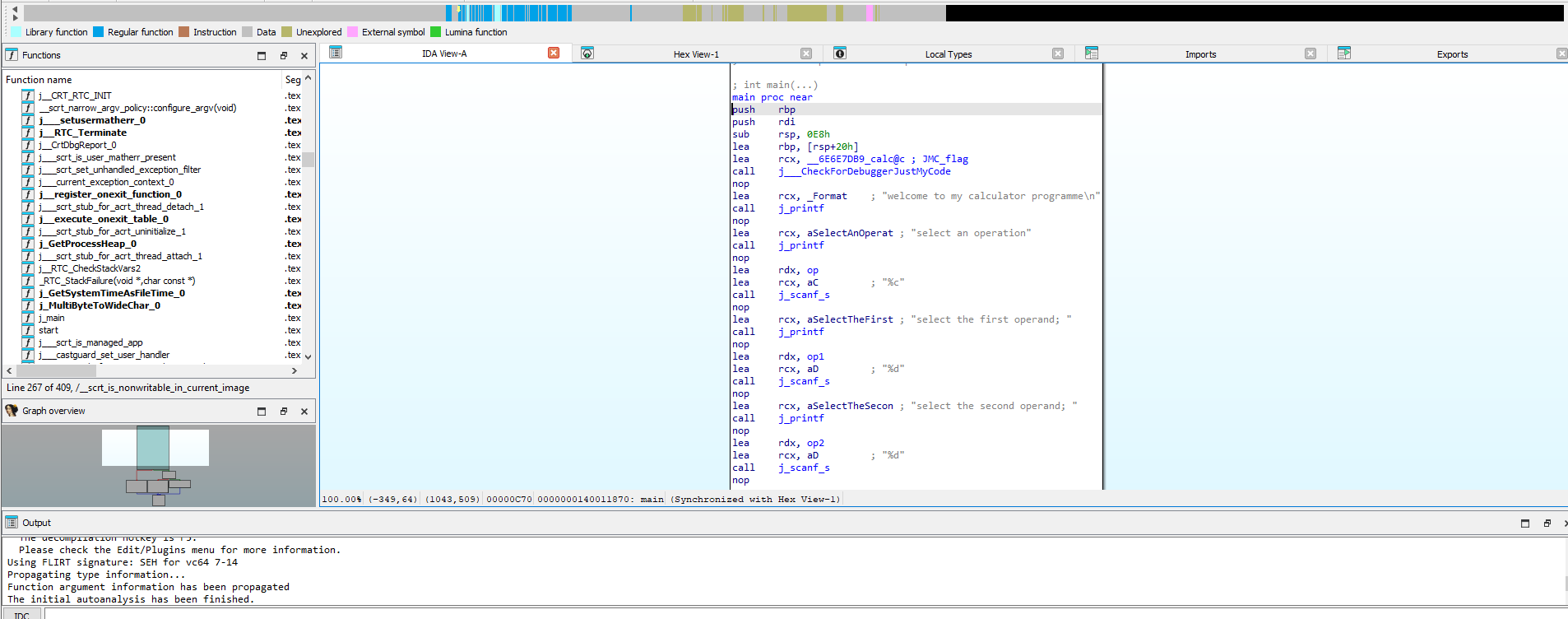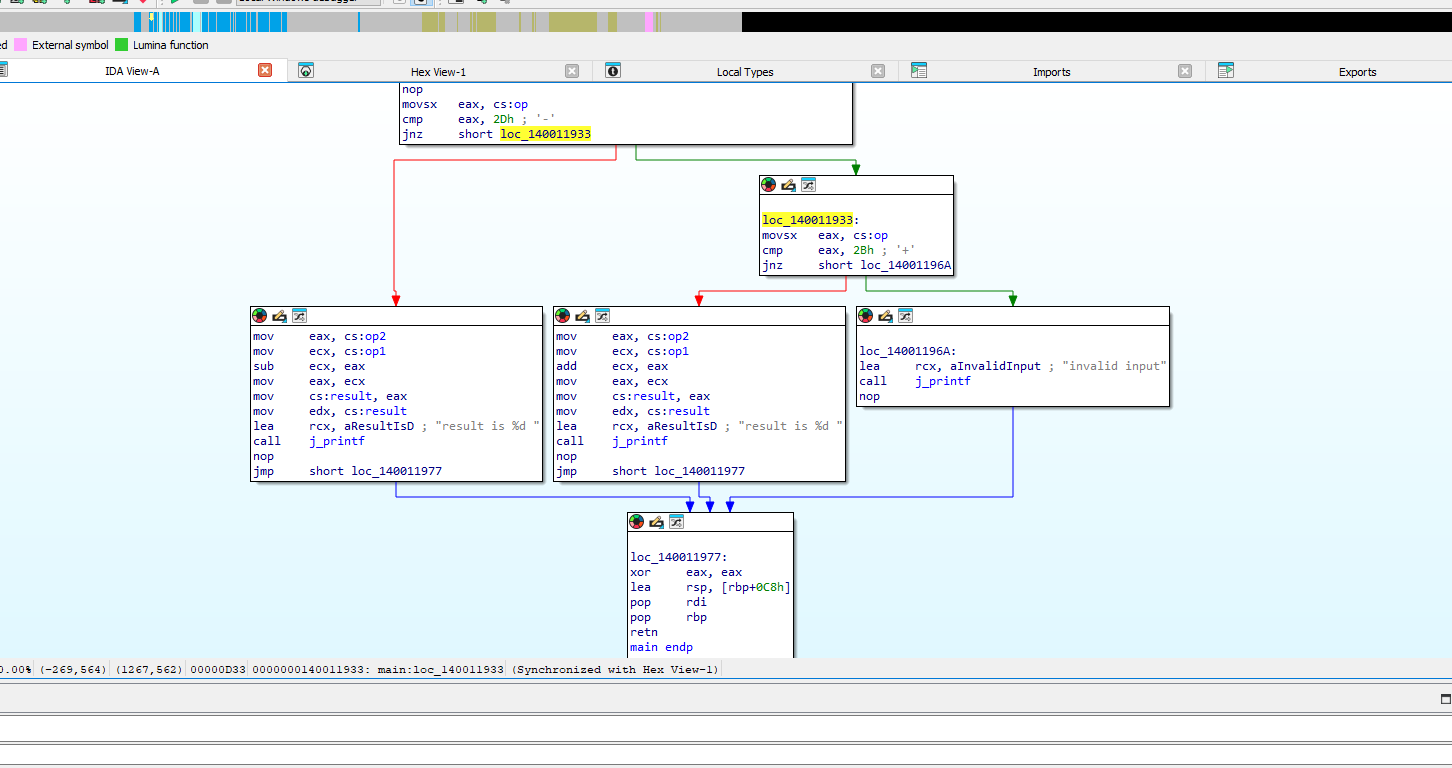Calculator
Coding and Reversing a very basic calculator in C.
Coding
Line 1-2
1
2
#include <stdio.h>
#include <stdlib.h>
These are the heaader files where I imported the standard libraries I would be needing in this project.
Line 3-6
1
2
3
4
char op
int op1
int op2
int result
Here, I declared all the variables I would be needing in this project
op is the operation to be performed.
op1 is the first operand, and is an integer.
op2 is the second operand, and is also an integer.
and result is the final integer gotten after the operation has been performed on the given operands.
Line 9
1
int main() {
This signifies the start of the main function
Line 10-16
1
2
3
4
5
6
7
printf("Welcome to my calculator programme\n");
printf("Select an operation");
scanf_s("%c", &op);
printf("Select the first operand; ");
scanf_s("%d", &op1);
printf("Select the second operand; ");
scanf_s("%d", &op2);
This segment of code prints out
1
2
Welcome to my calculator programme
select an operation
and then takes in the input before prompting the user to type in their first and second operands, which are the numbers they want to perform the opeartion on.
Line 18-30
1
2
3
4
5
6
7
8
9
10
11
12
13
14
if (op == '-'){
result = op1 - op2;
printf("result is %d ", result);
}
else if (op == '+'){
result = op1 + op2;
printf("result is %d ", result);
}
else{
printf("invalid input");
}
return 0;
}
This segment represents a conditional statement, if - else if - else.
It checks if the input matches either the subtractioon or addition operation respectively and performs the corresponding operation on the operands if it does. Otherwise, it prints out an error message invalid input.
Lines 28 - 30(12-14 here) ends the programme and signifies the closing of the main function.
Reversing
The next thing I did was to open up the code in IDA to see how it looked in assembly.
This is the first part of the disassembly of the main function
Segment 1
1
2
; int main(...)
main proc near
This segment signifies the start of the main function and corresponds to line 9 in the C code above.
Segment 2
1
2
3
4
5
6
7
push rbp
push rdi
sub rsp, 0E8h
lea rbp, [rsp+20h]
lea rcx, __6E6E7DB9_calc@c ; JMC_flag
call j___CheckForDebuggerJustMyCode
nop
This part is the compiler setting up the stack frame by adjusting the stack pointer(rsp) and saving important register values to it(rbp , rdi)
Segment 4
1
2
3
4
5
6
7
8
9
10
11
12
13
14
15
16
17
18
19
20
21
22
23
24
lea rcx, _Format ; "welcome to my calculator programme\n"
call j_printf
nop
lea rcx, aSelectAnOperat ; "select an operation"
call j_printf
nop
lea rdx, op
lea rcx, aC ; "%c"
call j_scanf_s
nop
lea rcx, aSelectTheFirst ; "select the first operand; "
call j_printf
nop
lea rdx, op1
lea rcx, aD ; "%d"
call j_scanf_s
nop
lea rcx, aSelectTheSecon ; "select the second operand; "
call j_printf
nop
lea rdx, op2
lea rcx, aD ; "%d"
call j_scanf_s
nop
This segment corresponds to lines 10 - 16 above which prompts the user to input the operator and operands and takes in their input.
This is the second part of the disassembly of the main function
Segment 5
1
2
3
movsx eax, cs:op
cmp eax, 2Dh ; '-'
jnz short loc_140011933
This corresponds to Line 18 above. It is the start of the next part of the code which is the if statement. It compares the user input to ‘-‘ and if user input is ‘-‘ it moves to the left branch as shown in the graph view of the disassembly above, otherwise it moves to the right signified by loc_140011933.
Segment 6
1
2
3
4
loc_140011933:
movsx eax, cs:op
cmp eax, 2Bh ; '+'
jnz short loc_14001196A
This corresponds to Line 22 in the C code. It goes on to compare user input to ‘+’, if this is valid it branches to the next segment on the left, other wise it branches to the right.
Segment 7
1
2
3
4
5
6
7
8
9
10
mov eax, cs:op2
mov ecx, cs:op1
add ecx, eax
mov eax, ecx
mov cs:result, eax
mov edx, cs:result
lea rcx, aResultIsD ; "result is %d "
call j_printf
nop
jmp short loc_140011977
This corresponds to Lines 23-25 . It is the segment the code moves to if user input is truly ‘+’. It performs the addition operation and prints out the result.
Segment 8
1
2
3
4
loc_14001196A:
lea rcx, aInvalidInput ; "invalid input"
call j_printf
nop
This corresponds to Lines 26-28. It is the segment the code jumps to after comparing user input to both ‘+’ and ‘-‘ and coming out false, it proceeds to print out the error message ‘invalid input’.
Segment 9
1
2
3
4
5
6
7
8
9
10
mov eax, cs:op2
mov ecx, cs:op1
sub ecx, eax
mov eax, ecx
mov cs:result, eax
mov edx, cs:result
lea rcx, aResultIsD ; "result is %d "
call j_printf
nop
jmp short loc_140011977
This is the segment the code jumps to if user input was truly ‘-‘ as stated in segment 5. After confirming that user input is really ‘-‘ it performs the subtraction operation and prints out the result. It corresponds to Lines 19-21 in the C code above.
Segment 10
1
2
3
4
5
6
7
loc_140011977:
xor eax, eax
lea rsp, [rbp+0C8h]
pop rdi
pop rbp
retn
main endp
This is the last segment of relevant code, where the stack is being cleaned. It signifies the end of the main function. Corresponds to Lines 29-30 above.
The end.


